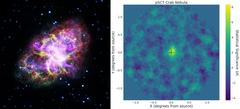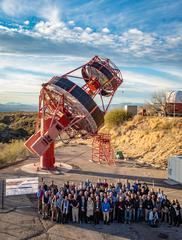URL: https://www.desy.de/news/news_search/index_eng.html
Breadcrumb Navigation
DESY News: Novel gamma-ray telescope detects Crab Nebula
News
News from the DESY research centre
Novel gamma-ray telescope detects Crab Nebula
The prototype of a novel telescope has successfully detected the Crab Nebula, the standard candle in gamma-ray astronomy. The detection proves the viability of the Schwarzschild-Couder telescope design that could enhance the capabilities of the upcoming Cherenkov Telescope Array (CTA), the gamma-ray observatory of the future. The success was announced by CTA scientists at the 236th meeting of the American Astronomical Society (AAS). DESY scientists and engineers have contributed to the prototype Schwarzschild-Couder Telescope (pSCT) and built the tower and drive of the telescope that was inaugurated at the Fred Lawrence Whipple Observatory in Arizona in January 2019.
Gamma rays are the highest energy photons in the universe and originate from the most violent processes in the cosmos. They can illuminate the physics of extreme objects like black holes, give insights into the broad scale evolution of the universe and might even unveil the nature of the mysterious dark matter that is more than five times as abundant in the cosmos than the ordinary matter that we are used to. Also, gamma-ray astronomy is central to the emerging field of multi-messenger astronomy, illuminating the cosmos in the light of different messengers like photons, gravitational waves as well as neutrinos and other particles.“The Crab Nebula is the touchstone of gamma-ray astronomy, and its detection is an excellent proof of the pSCT technology,” said Markus Garczarczyk, DESY project leader for tower and drive. The pSCT is based on a 114-year-old concept of the German physicist Karl Schwarzschild (1873-1916), which has only become feasible today due to technical progress. In contrast to conventional gamma-ray telescopes, the pSCT has a double mirror system, which should increase the quality of the focused light and enable the use of compact light sensors. The pSCT main mirror has a diameter of 9.7 meters and consists of 48 mirror elements. The 5.4 meter secondary mirror consists of 24 segments.

The Crab Nebula with its pulsar in the center (left) is the brightest steady source of very high-energy gamma radiation in the sky (right: detection by pSCT). The nebula is the remnant of a supernova from the year 1054. Credits: NASA; ESA; G. Dubner (IAFE, CONICET-University of Buenos Aires) et al.; A. Loll et al.; T. Temim et al.; F. Seward et al.; VLA/NRAO/AUI/NSF; Chandra/CXC; Spitzer/JPL-Caltech; XMM-Newton/ESA; and Hubble/STScI (links); CTA/SCT consortium (rechts)
The pSCT was made possible by the contributions of thirty institutions and five critical industry partners across the United States, Italy, Germany, Japan, and Mexico. “The pSCT telescope tower including its drive are based on the design of the CTA Medium Sized Telescopes, developed by DESY engineers,” explains Garczarczyk. “The individual components were produced in Europe, then pre-assembled at the DESY site in Zeuthen and sent to the Fred Lawrence Whipple Observatory (FLWO) in Arizona.” The tower and drive were installed and commissioned by DESY and FLWO engineers in 2016. Since then, DESY colleagues have been supporting the project and the US colleagues during integration, operation, maintenance and also in data analysis.
For more information visit http://cta-observatory.org/




